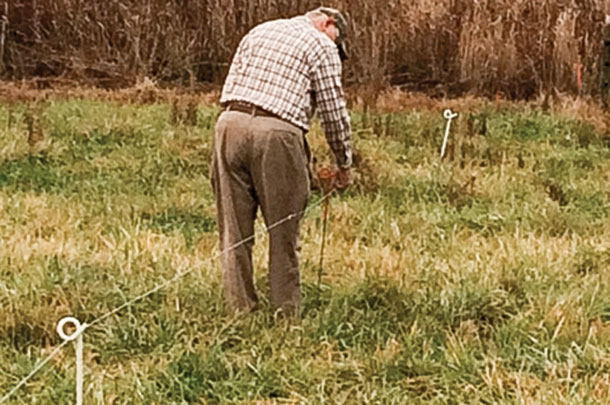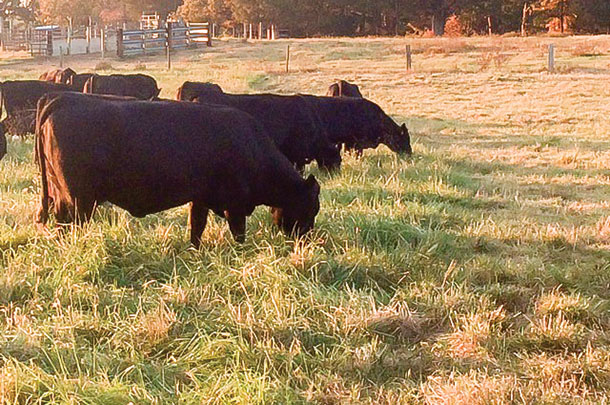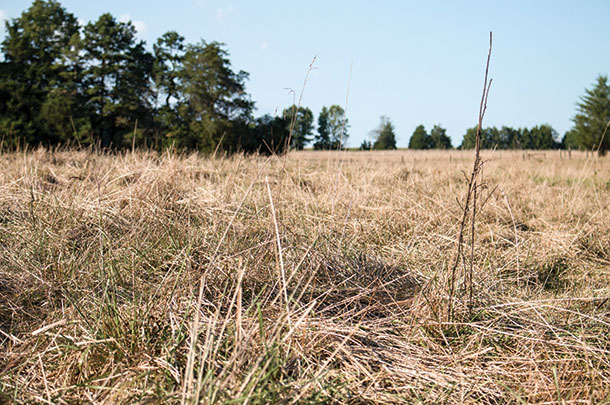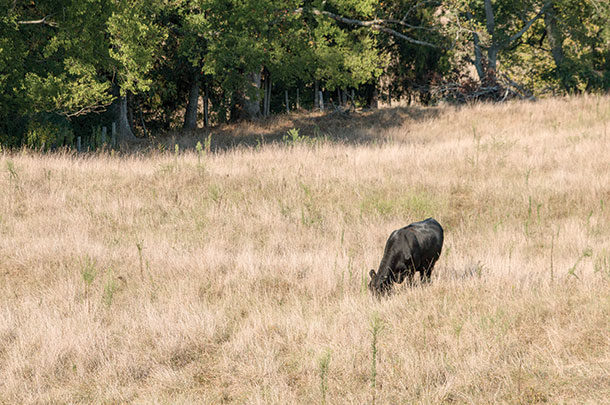A commercial seedstock operation since 1988, this father and son duo does everything a registered operation does – just without the association papers. They keep detailed records, utilize artificial insemination technology and provide their customers with a product that will suit their goals and most importantly, their location.
Because they live in an area of primarily small-scale beef producers, the Deals focus a good part of their selection on docility – making it easier for those with off-farm jobs to care for the herd.
But that’s not all; reproductive efficiency, fleshing ability and reduction in fescue toxicity issues are also key components in their selection and culling criteria.
“Our breeding emphasis on reproduction and some of these other criteria are key to us,” Eric says. “We sell cows, we may even sell our favorite cow but she has to meet these selection points, especially when it comes to meeting our 30-day breeding window on heifers and 50-day window on cows.
We’re really strict on that and getting our new style, or our new way of managing our pastures to complement that.”
A 365-day goal
That “new way of managing pastures” Eric refers to started after attending a few grazing workshops about six or seven years ago.
By going to on-farm demonstrations and learning from experts in their area, the cogs in the Deals’ brains began to turn until they found themselves slowly migrating toward less feeding and more grazing.
The Deals’ cattle are rotationally strip grazed from October to March to try and achieve their goal of year-round grazing. In order to limit the amount of hay fed, they stockpile close to 75 percent of their pastures. The rest of the 25 percent isn’t set up to stockpile and graze correctly, Eric says.
 According to the Deals, stockpiling correctly means setting up the proper infrastructure – waterers and temporary fencing – and appropriate management of both land and cattle.
According to the Deals, stockpiling correctly means setting up the proper infrastructure – waterers and temporary fencing – and appropriate management of both land and cattle.
They fertilize in the fall and allow for new growth in September, October and the first couple weeks of November to help the grass hold its value through the winter.
Eric explains that a producer “can’t just see that he or she has a lot of grass out there and call it stockpiling; it needs to be fall growth.” It can only stand out there for so long before it loses its quality, he says.
To control how much feed the cattle have available and when, the Deals use step-in posts and electric wire, which is moved everyday. Portable water troughs and mineral feeders are also used to distribute manure and to keep from overusing or killing the grass stand.
“If you can properly meter it out and give them what they need in one day, the average analysis of that grass is pretty good. You can’t do it without moving your fence and strip grazing,” he says. “They’ll go out and nip the tops off, and the cows may look good the first week, but by the second and third they’ll look bad.”
Both agree they have been pleased with the performance of their cattle on the stockpiled pastures. If done correctly, Eric says, “The fescue quality is very high – higher than most average-quality hay baled off the same pastures in the summer. Cattle can look better, if managed right, through the winter on stockpiled fescue.”
This winter marks four years since the Deals sold their hay equipment, quit making their own hay and began aiming for the 365 days grazing goal. Eric says they don’t always make it, but most years they’ve “come pretty dang close.”
It’s all in the plan
Everything on Circle D Farms is strategically planned. Whether it’s utilizing fall calving to match their grasses’ peak production or flip-flopping cows from herd to herd to manage fescue toxicity – everything has its place and its reason.
“With the way we have things set up, the calves are old enough to go on grass when spring comes and the grass comes out,” Eric says to explain why fall calving works for them.
“The cows’ milk fluid increases on the spring grass and help contribute to the calves’ growth. Then in April or May when we wean, we get the good growth of the calves while fescue and a few other forages are at their best. That way dry cows are carried through the summer when it’s hot rather than having to try and produce milk.”
Eric says a lot of people believe calving should follow nature – with calves born in the spring. However, because they are able to stockpile fescue, and have enough moisture to grow it, they feel that stockpiling throws a wrench in the spring calving theory. “We have quality grass in the winter, so this system really works for us,” he says.
 When summer comes and the risk of fescue toxicity is on the rise, the Deals use multiple methods to keep their cow herd’s production up to par. Besides culling animals with low coat shed, the Deals rotate their herds between pastures with common bermuda and native warm-season species like switchgrass and big bluestem.
When summer comes and the risk of fescue toxicity is on the rise, the Deals use multiple methods to keep their cow herd’s production up to par. Besides culling animals with low coat shed, the Deals rotate their herds between pastures with common bermuda and native warm-season species like switchgrass and big bluestem.
“We have been very tickled with how cattle perform on that bermudagrass in the summer,” Oscho says. “We feel that if we can give them even a couple of weeks off of the fescue and then let them go back on some fescue and so forth, we see a lot better performance in our animals."
"For us, that has been the best way to handle fescue toxicity.”
On a more recent note, the Deals have also started using matua, a prairie bromegrass, to interseed a non-fescue grass into their established fescue pastures. This is done by baling the grass a little on the mature side, allowing for the seeds to be baled with the hay.
When the hay is unrolled and fed, the cattle will trample the seeds into the soil while eating the hay or spread the seeds across the pasture through their manure.
“This is something we learned at one of our grazing workshops,” Oscho says. “We unrolled some of the hay during our dry time this fall and with a little rain, we have started to see the seeds coming up. Our goal is to unroll this hay in areas that need a better grass stand. We are excited to see how this works.”
Focus on efficiency
As any producer can attest, your cattle are only as good as the resources you have available, but adding to that, some cattle are better suited for the job. Eric explains how they used to run Gelbvieh cattle but realized from a functionality standpoint in the pasture, the breed wasn’t quite meeting its mark.
 The Gelbvieh breed could really put on the pounds, Eric says, but that wasn’t what they needed in their new grazing system. Looking for a breed that was a little more “easier keeping” on the forages, the Deals switched to an English-influenced breed: Angus.
The Gelbvieh breed could really put on the pounds, Eric says, but that wasn’t what they needed in their new grazing system. Looking for a breed that was a little more “easier keeping” on the forages, the Deals switched to an English-influenced breed: Angus.
Since their switch in breeds, the Deals have been pleased with their decision – not because anything was wrong with the Gelbvieh breed – but because Angus has worked better in their program. They now have close to 75 Angus cows, and a few Gelbvieh cows left over from their previous herd.
The Deals will be the first to admit their pasture and cattle management isn’t perfect; they talk about getting better utilization out of their pastures at the dinner table, worry about overgrazing and the pasture soil health and struggle to maintain their strict culling criteria. But in Eric’s words, “It all works pretty good together if you can just get it to synch up.” ![]()
PHOTO 1: This photo was taken in the last cycle of summer growth. This pasture hadn’t been grazed since spring, so there was a lot of old growth. Eric says the old growth can be beneficial to soil health as it’s trampled and becomes organic matter or litter. Photo by Cassidy Woolsey.
PHOTO 2: Oscho stringing temporary electric fence wire with step-in posts. This allows for easy setup and takedown when moving the cattle to the next grazing section.
PHOTO 3: This photo shows the new grass height and the grazed grass height.
PHOTO 4: This photo shows the amount of residue the Deals try to leave behind. The cattle were taken off the pasture three weeks before the photo was taken. Normally they have more regrowth but they were in the middle of a drought. Photos provided by Eric Deal.

-
Cassidy Woolsey
- Editor
- Progressive Forage
- Email Cassidy Woolsey












